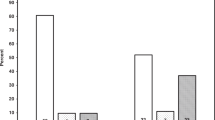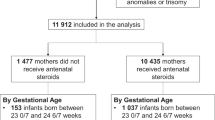Abstract
Objective
Investigate if antenatal corticosteroids (ANCS) are associated with worse kidney function in adolescence and if greater adiposity magnifies this association.
Study design
Prospective cohort of 162 14-year-olds born preterm with very low birth weight (<1500 g). Outcomes were estimated glomerular filtration rate (eGFR) and first-morning urine albumin-to-creatinine ratio (UACR). We used adjusted generalized linear models, stratified by waist-to-height ratio (WHR) ≥ 0.5.
Results
Fifty-five percent had ANCS exposure and 31.3% had WHR ≥ 0.5. In adjusted analyses of the entire cohort, ANCS was not significantly associated with eGFR or UACR. However, the ANCS-eGFR association was greater in those with WHR ≥ 0.5 (β −16.8 ml/min/1.73 m2, 95% CL −31.5 to −2.1) vs. WHR < 0.5: (β 13.9 ml/min/1.73 m2, 95% CL −0.4 to 28.1), interaction term p = 0.02.
Conclusion
ANCS exposure was not associated with worse kidney function in adolescence, though ANCS may be associated with lower eGFR if children develop obesity by adolescence.
This is a preview of subscription content, access via your institution
Access options
Subscribe to this journal
Receive 12 print issues and online access
$259.00 per year
only $21.58 per issue
Buy this article
- Purchase on Springer Link
- Instant access to full article PDF
Prices may be subject to local taxes which are calculated during checkout


Similar content being viewed by others
Data availability
The datasets generated from this study are available from the corresponding author upon reasonable request.
Code availability
The code used to analyze the data from this study are available from the corresponding author upon reasonable request.
References
Abitbol CL, Bauer CR, Montané B, Chandar J, Duara S, Zilleruelo G. Long-term follow-up of extremely low birth weight infants with neonatal renal failure. Pediatr Nephrol. 2003;18:887–93.
Liao L, Deng Y, Zhao D. Association of low birth weight and premature birth with the risk of metabolic syndrome: a meta-analysis. Front Pediatr. 2020;8:405.
Kaijser M, Bonamy AK, Akre O, Cnattingius S, Granath F, Norman M, et al. Perinatal risk factors for ischemic heart disease: disentangling the roles of birth weight and preterm birth. Circulation. 2008;117:405–10.
Crump C, Howell EA, Stroustrup A, McLaughlin MA, Sundquist J, Sundquist K. Association of preterm birth with risk of ischemic heart disease in adulthood. JAMA Pediatr. 2019;173:736–43.
Carr H, Cnattingius S, Granath F, Ludvigsson JF, Edstedt Bonamy AK. Preterm birth and risk of heart failure up to early adulthood. J Am Coll Cardiol. 2017;69:2634–42.
Mathai S, Derraik JG, Cutfield WS, Dalziel SR, Harding JE, Biggs J, et al. Increased adiposity in adults born preterm and their children. PLoS ONE. 2013;8:e81840.
Hovi P, Andersson S, Eriksson JG, Jarvenpaa AL, Strang-Karlsson S, Makitie O, et al. Glucose regulation in young adults with very low birth weight. N. Engl J Med. 2007;356:2053–63.
South AM, Nixon PA, Chappell MC, Diz DI, Russell GB, Jensen ET, et al. Renal function and blood pressure are altered in adolescents born preterm. Pediatr Nephrol. 2019;34:137–44.
de Jong F, Monuteaux MC, van Elburg RM, Gillman MW, Belfort MB. Systematic review and meta-analysis of preterm birth and later systolic blood pressure. Hypertension. 2012;59:226–34.
Bartholomew J, Kovacs L, Papageorgiou A. Review of the antenatal and postnatal use of steroids. Indian J Pediatr. 2014;81:466–72.
Liggins GC, Howie RN. A controlled trial of antepartum glucocorticoid treatment for prevention of the respiratory distress syndrome in premature infants. Pediatrics. 1972;50:515–25.
South AM, Nixon PA, Chappell MC, Diz DI, Russell GB, Snively BM, et al. Antenatal corticosteroids and the renin-angiotensin-aldosterone system in adolescents born preterm. Pediatr Res. 2017;81:88–93.
Doyle LW, Ford GW, Davis NM, Callanan C. Antenatal corticosteroid therapy and blood pressure at 14 years of age in preterm children. Clin Sci. 2000;98:137–42.
Figueroa JP, Rose JC, Massmann GA, Zhang J, Acuña G. Alterations in fetal kidney development and elevations in arterial blood pressure in young adult sheep after clinical doses of antenatal glucocorticoids. Pediatr Res. 2005;58:510–5.
South AM, Nixon PA, Chappell MC, Diz DI, Russell GB, Shaltout HA, et al. Obesity is associated with higher blood pressure and higher levels of angiotensin II but lower angiotensin-(1-7) in adolescents born preterm. J Pediatr. 2019;205:55–60.e1.
Massmann GA, Zhang J, Seong WJ, Kim M, Figueroa JP. Sex-dependent effects of antenatal glucocorticoids on insulin sensitivity in adult sheep: role of the adipose tissue renin angiotensin system. Am J Physiol Regul Integr Comp Physiol. 2017;312:R1029–R38.
Lakkis JI, Weir MR. Obesity and kidney disease. Prog Cardiovasc Dis. 2018;61:157–67.
Ritz E. Metabolic syndrome and kidney disease. Blood Purif. 2008;26:59–62.
Laville M. [Renal consequences of obesity]. Nephrol Ther. 2011;7:80–5.
Washburn LK, Nixon PA, Snively BM, Russell GB, Shaltout HA, South AM, et al. Antenatal corticosteroids and cardiometabolic outcomes in adolescents born with very low birth weight. Pediatr Res. 2017;82:697–703.
Oken E, Kleinman KP, Rich-Edwards J, Gillman MW. A nearly continuous measure of birth weight for gestational age using a United States national reference. BMC Pediatr. 2003;3:6.
Battaglia FC, Lubchenco LO. A practical classification of newborn infants by weight and gestational age. J Pediatr. 1967;71:159–63.
Nixon PA, Shaltout HA, South AM, Jensen ET, O’Shea TM, Brown CL, et al. Antenatal steroid exposure, aerobic fitness, and physical activity in adolescents born preterm with very low birth weight. J Pediatr. 2019;215:98–106.e2.
McDowell MA, Fryar CD, Ogden CL, Flegal KM. Anthropometric reference data for children and adults: United States, 2003-6. Natl Health Stat Rep. 2008;10:1–48.
Barlow SE. Expert committee recommendations regarding the prevention, assessment, and treatment of child and adolescent overweight and obesity: summary report. Pediatrics 2007;120:S164–92.
Harrington DM, Staiano AE, Broyles ST, Gupta AK, Katzmarzyk PT. BMI percentiles for the identification of abdominal obesity and metabolic risk in children and adolescents: evidence in support of the CDC 95th percentile. Eur J Clin Nutr. 2013;67:218–22.
Washburn L, Nixon P, Russell G, Snively BM, O’Shea TM. Adiposity in adolescent offspring born prematurely to mothers with preeclampsia. J Pediatr. 2013;162:912–7.e1.
Martin-Calvo N, Moreno-Galarraga L, Martinez-Gonzalez MA. Association between body mass index, waist-to-height ratio and adiposity in children: a systematic review and meta-analysis. Nutrients. 2016;8:512.
McGuire S. U.S. Department of Agriculture and U.S. Department of Health and Human Services, Dietary Guidelines for Americans, 2010. 7th edition, Washington, DC: U.S. Government Printing Office, January 2011. Adv Nutr. 2011;2:293–4.
National High Blood Pressure Education Program Working Group on High Blood Pressure in Children and Adolescents. The fourth report on the diagnosis, evaluation, and treatment of high blood pressure in children and adolescents. Pediatrics. 2004;114:555–76.
Rosner B, Cook N, Portman R, Daniels S, Falkner B. Determination of blood pressure percentiles in normal-weight children: some methodological issues. Am J Epidemiol. 2008;167:653–66.
Flynn JT, Kaelber DC, Baker-Smith CM, Blowey D, Carroll AE, Daniels SR, et al. Clinical practice guideline for screening and management of high blood pressure in children and adolescents. Pediatrics 2017;140:e20171904.
Schwartz GJ, Brion LP, Spitzer A. The use of plasma creatinine concentration for estimating glomerular filtration rate in infants, children, and adolescents. Pediatr Clin N Am. 1987;34:571–90.
Shah SM, South AM. Association of kidney function with posterior reversible encephalopathy syndrome in children. Clin Nephrol. 2022;98:10–5.
Cohen JB, D’Agostino McGowan L, Jensen ET, Rigdon J, South AM. Evaluating sources of bias in observational studies of angiotensin-converting enzyme inhibitor/angiotensin II receptor blocker use during COVID-19: beyond confounding. J Hypertens. 2021;39:795–805.
Textor J, Hardt J, Knüppel S. DAGitty: a graphical tool for analyzing causal diagrams. Epidemiology. 2011;22:745.
Ortiz LA, Quan A, Weinberg A, Baum M. Effect of prenatal dexamethasone on rat renal development. Kidney Int. 2001;59:1663–9.
al-Dahan J, Stimmler L, Chantler C, Haycock GB. The effect of antenatal dexamethasone administration on glomerular filtration rate and renal sodium excretion in premature infants. Pediatr Nephrol. 1987;1:131–5.
Amador-Licona N, Guizar-Mendoza JM, Maciel-Miranda JA, Romero-Gutierrez G. Antenatal dexamethasone and renal vascular resistance in preterm infants. J Paediatr Child Health. 2007;43:303–6.
Carballo-Magdaleno D, Guizar-Mendoza JM, Amador-Licona N, Dominguez-Dominguez V. Renal function, renal volume, and blood pressure in infants with antecedent of antenatal steroids. Pediatr Nephrol. 2011;26:1851–6.
Moisiadis VG, Matthews SG. Glucocorticoids and fetal programming part 2: mechanisms. Nat Rev Endocrinol. 2014;10:403–11.
Cattarelli D, Chirico G, Simeoni U. Renal effects of antenatally or postnatally administered steroids. Pediatr Med Chir. 2002;24:157–62.
Nehus E, Mitsnefes M. Childhood obesity and the metabolic syndrome. Pediatr Clin N Am. 2019;66:31–43.
Yim HE, Yoo KH. Early life obesity and chronic kidney disease in later life. Pediatr Nephrol. 2015;30:1255–63.
Chalmers L, Kaskel FJ, Bamgbola O. The role of obesity and its bioclinical correlates in the progression of chronic kidney disease. Adv Chronic Kidney Dis. 2006;13:352–64.
South AM, Shaltout HA, Gwathmey TM, Jensen ET, Nixon PA, Diz DI, et al. Lower urinary alpha-Klotho is associated with lower angiotensin-(1-7) and higher blood pressure in young adults born preterm with very low birthweight. J Clin Hypertens. 2020;22:1033–40.
Pasala S, Carmody JB. How to use… serum creatinine, cystatin C and GFR. Arch Dis Child Educ Pract Ed. 2017;102:37–43.
Acknowledgements
The authors thank the participants and their families, Alice Scott, RN, research study coordinator, and Patricia Brown, RN, research nurse, both of whom have no conflicts of interest.
Funding
This study was funded by the National Institutes of Health: National Institute of Diabetes and Digestive and Kidney Diseases T35DK007400, Eunice Kennedy Shriver National Institute of Child Health and Human Development P01HD047584 and P01HD084227, National Center for Research Resources M01RR07122 to the Clinical Research Unit of Wake Forest Baptist Medical Center, and National Center for Advancing Translational Sciences UL1TR001420 to the Wake Forest Clinical and Translational Science Award; the American Heart Association (14GRNT20480131 and 18TPA34170522), and the Forsyth Medical Center and Wake Forest University School of Medicine Department of Pediatrics research funds. AMS additionally reports funding from the National Institutes of Health National Heart, Lung, and Blood Institute K23HL148394, L40HL148910, R01HL146818, and R56HL164434.
Author information
Authors and Affiliations
Contributions
WNF conceptualized the research question, visualized the data and assisted with data interpretation, drafted the initial manuscript, and revised the manuscript. DPB assisted in the design of the analytic plan, analyzed the data, assisted with interpreting the data, and revised the manuscript. ETJ assisted in the study design, analytic plan, and interpretation of the results and revised the manuscript. LKW conceptualized and designed the study, supervised data collection, and revised the manuscript. AMS assisted with developing the research question, conceptualized and designed the analytic plan, assisted with analyzing and interpreting the data, created the figures, at all times had full access to and takes full responsibility for the data, and revised the manuscript. All authors approved the final manuscript as submitted and agree to be accountable fully for all aspects of the work.
Corresponding author
Ethics declarations
Competing interests
The authors declare no competing interests.
Consent to participate
Written informed consent from parents or legal guardians and assent from participants were obtained.
Additional information
Publisher’s note Springer Nature remains neutral with regard to jurisdictional claims in published maps and institutional affiliations.
Rights and permissions
Springer Nature or its licensor (e.g. a society or other partner) holds exclusive rights to this article under a publishing agreement with the author(s) or other rightsholder(s); author self-archiving of the accepted manuscript version of this article is solely governed by the terms of such publishing agreement and applicable law.
About this article
Cite this article
Floyd, W.N., Beavers, D.P., Jensen, E.T. et al. Association of antenatal corticosteroids with kidney function in adolescents born preterm with very low birth weight. J Perinatol 43, 1038–1044 (2023). https://doi.org/10.1038/s41372-023-01688-3
Received:
Revised:
Accepted:
Published:
Issue Date:
DOI: https://doi.org/10.1038/s41372-023-01688-3



